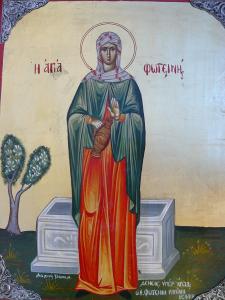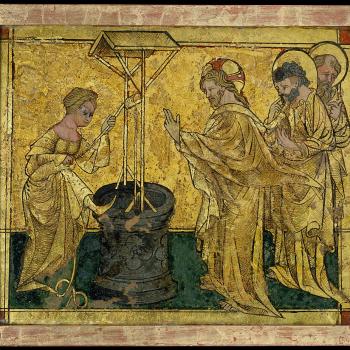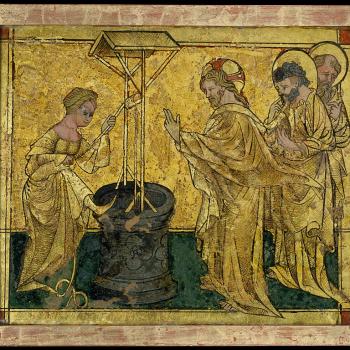
One of the ways early Christians looked at Scripture was for the way it should be read, not as mere positive history, not as some simple text to be read literally, but as a text which gives us all kinds of theological truths through various symbols inserted into the narratives themselves. That is, they did not take Scripture as a simple history book. They did not believe that everything which was written down happened exactly in the way it was described; they understood, indeed, that various contradictions in historical narratives indicated that this was not meant to be the way it was viewed. This, of course, was normal in the ancient world, not just for Christians, but for ancient historians in general. As many particular details were unavailable to them, they had to be supplied by the writers themselves. Thus, history was more about giving a general presentation of what happened funneled by the historian’s creative attempt to reconstruct the event. What they wrote about was, in general, were believed to have happened, but just not in the precise way the historians recorded those events. The historian, therefore, often interpreted the events and used their own interpretation in creating their narratives, hoping to lead their audience to understand the meaning of history the same way they did. Scripture often followed the same methodology; thus, if what is written is not entirely factual, it was not because the writers were intending to deceive their reader, but rather, they wanted to present various truths, especially theological truths, by their reading of history. This makes what they wrote more akin to myth than it is empirical history. This is why they wrote histories with symbols and with dialogues which might not have been engaged the way they were written down; what the writers were interested in doing is given a broad outline of the events and then supplying the means to find the truth which can be discerned through the event itself. We can read the story of the Samaritan woman (St Photina) as being an example of this.
St. Photina, the early Christians recognized, was a real woman, and beyond what was described in Scripture, she had an important role in the early Christian community. And while it is true that we can see, even in the apostolic times, women were slowly being sidelined, that their voice was being more and more ignored (if not outright suppressed), the way they had been lifted up and promoted by Jesus made sure they could not be quickly silenced. Thus, we find that they had a more vital role in the early community than they would have just a few centuries later. The trajectory of their subjugation and silence began during the apostolic era, but it would not be at its worst until much later. This is why we can find many important women, like St. Photina, capable of having a role in evangelization, even preaching. The fact that she held such a role should not have us ignore the way she, and other women, found themselves being sidelined, as if they were second class citizens in the church (despite the way Paul said differences in gender should not be seen in Christ). Nonetheless, while all of this is true, Scripture does not tell us her later story, only the way she first met Christ. How Scripture explains that meeting is full of symbols, so much so, that it is obvious it is meant more to express theological truths than it is to elevate the status of Photina:
There came a woman of Samaria to draw water. Jesus said to her, “Give me a drink.” For his disciples had gone away into the city to buy food. The Samaritan woman said to him, “How is it that you, a Jew, ask a drink of me, a woman of Samaria?” For Jews have no dealings with Samaritans. Jesus answered her, “If you knew the gift of God, and who it is that is saying to you, `Give me a drink,’ you would have asked him, and he would have given you living water.” The woman said to him, “Sir, you have nothing to draw with, and the well is deep; where do you get that living water? Are you greater than our father Jacob, who gave us the well, and drank from it himself, and his sons, and his cattle?” Jesus said to her, “Every one who drinks of this water will thirst again, but whoever drinks of the water that I shall give him will never thirst; the water that I shall give him will become in him a spring of water welling up to eternal life” (Jn. 4:7-14 RSV).
The theological truths connected to her meeting with Christ were often emphasized by early commentators as they saw her representing the way fallen humanity was often trapped by seeking after and embracing mere material sensations. The Samaritan woman’s five husbands which were really not husbands were often believed to represent the five senses and the way our souls have been seduced by them so as to ignore our spiritual heritage. We can see an example of this tradition in St. Augustine’s Tractates on John:
But since we are hemmed in by what follows, “And he whom you now have is not your husband,” it appears to me that we can more easily take the five senses of the body to be the five former husbands of the soul. For when one is born, before he can make use of the mind and reason, he is ruled only by the senses of the flesh. In a little child, the soul seeks for or shuns what is heard, and seen, and smells, and tastes, and is perceived by the touch. It seeks for whatever soothes, and shuns whatever offends, those five senses. At first, the soul lives according to these five senses, as five husbands; because it is ruled by them. But why are they called husbands? Because they are lawful and right: made indeed by God, and are the gifts of God to the soul. The soul is still weak while ruled by these five husbands, and living under these five husbands; but when she comes to years of exercising reason, if she is taken in hand by the noble discipline and teaching of wisdom, these five men are succeeded in their rule by no other than the true and lawful husband, and one better than they, who both rules better and rules for eternity, who cultivates and instructs her for eternity. For the five senses rule us, not for eternity, but for those temporal things that are to be sought or shunned. But when the understanding, imbued by wisdom, begins to rule the soul, it knows now not only how to avoid a pit, and to walk on even ground — a thing which the eyes show to the soul even in its weakness; nor merely to be charmed with musical voices, and to repel harsh sounds; nor to delight in agreeable scents, and to refuse offensive smells; nor to be captivated by sweetness, and displeased with bitterness; nor to be soothed with what is soft, and hurt with what is rough. For all these things are necessary to the soul in its weakness.[1]
While John was telling us about an event in Jesus’ life, it was understood that he wrote it to highlight theological truths, not mere facts. The readers were meant to understand not everything was to be taken literally. He was writing with symbols, symbols they were meant to interpret so as to discern the transcendent truth(s) revealed in Photina’s meeting with Jesus. He expected his audience to wrestle with the text, and not take it at its face value. When we do as John wanted, we will probably see that there are a wide variety of interpretations which we can come up from what he wrote. Perhaps that is also the point, especially here. We are told we should be seeking living water, that is the Spirit, and the Spirit is not going to be trapped by the mere letter of the text; trying to impose only one interpretation upon the narrative is to make the mistake that those who engage a simple literal take of Scripture makes. That is, we would limit what the Spirit can and will reveal through the text itself. We should expect there will be many complementary interpretations of the text, each using the carefully crafted telling of the story to lead us to transcendent truths which cannot be fully put into words. This highlights why the text is best understood as being mythic and not positive history, for myth always is about serving as a revelation of the truth in a way which transcends a simple literal reading of the tale. Early Christians understood this, which is why they were focused more on the allegorical interpretation of Scripture than its literal meanings.
Today, we might not be as interested in allegorical interpretations of Scriptural texts as many ancient Christians were; we might be more interested in positive history, that is, in discerning the historical facts behind the narrative, but we must not let ourselves become trapped by such an interest, thinking it can provide all that we should ever want to learn from the texts themselves. If we do so, we will find ourselves struggling to find out what the text could provide us, how it can lead us to the living water which we need, the nourishment which satisfies our spiritual needs. What is important are the theological truths which can be apprehended in and from the texts. Discerning the historical facts which helped in the creation of the story certainly can offer us one means to do so, to be sure, but it does so only to a limited degree. Every interpretive scheme has much to offer, but they work better in unison than apart. This is why modern Biblical criticism and its questions should not be ignored, just as ancient ways of engaging Scripture should also not be ignored.
While Scripture does not merely give us a presentation of empirical facts, we should not take that to mean the text is pure fiction. Rather, we must understand Scripture to be historical myth, where history is used to create narratives which point to those great, transcendent truths which will help nourish the soul. Biblical criticism will help us discern the history, and other interpretative schemes will be able to point out the truths the Spirit can and will provide us from the text if we but let it
[1] St. Augustine, Tractates on John in NPNF1(7): 104 [Tractate XV.21]
Stay in touch! Like A Little Bit of Nothing on Facebook.
If you liked what you read, please consider sharing it with your friends and family!
N.B.: While I read comments to moderate them, I rarely respond to them. If I don’t respond to your comment directly, don’t assume I am unthankful for it. I appreciate it. But I want readers to feel free to ask questions, and hopefully, dialogue with each other. I have shared what I wanted to say, though some responses will get a brief reply by me, or, if I find it interesting and something I can engage fully, as the foundation for another post. I have had many posts inspired or improved upon thanks to my readers.













